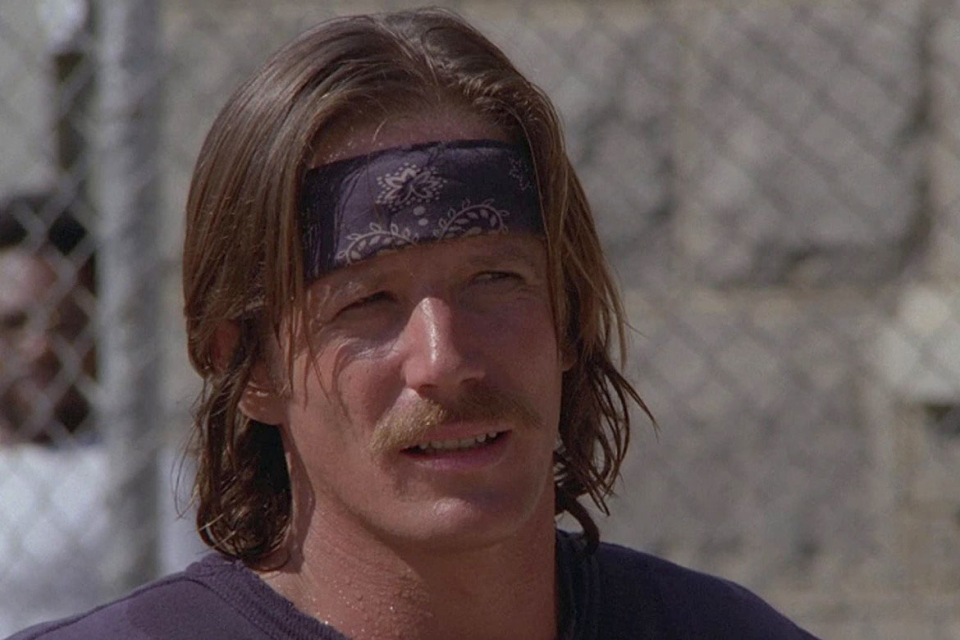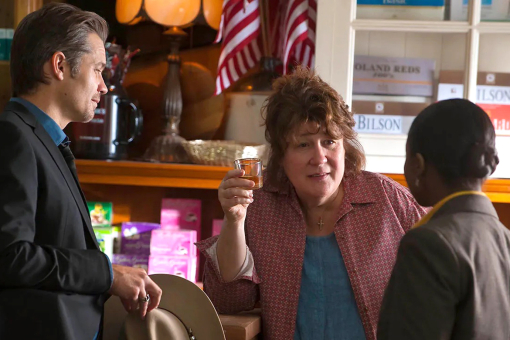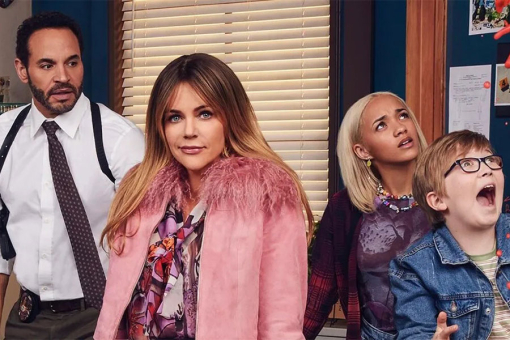“I usually remember every moment of every film I’ve shot. That’s kind of my chronology.”
Michael Mann has a vivid memory. One that allows the 81-year-old filmmaker to effortlessly recall (in exacting, “you are there” detail) behind-the-scenes moments from all of his iconic works — from TV’s Miami Vice to his cinematic crime epic Heat. Mann’s contributions to pop culture have constructed some of its most iconic load-bearing columns — with the first brick in that considerable foundation laid 45 years ago today with the airing of the writer-director’s landmark TV movie event, ABC’s The Jericho Mile.
Written and directed by Mann, and with the gritty verisimilitude that would become a hallmark of the director’s narrative voice, Jericho Mile centers on loner convict Larry “Rain” Murphy (Peter Strauss), who is serving time in Folsom Prison for first-degree murder of his father, which Murphy justifies because his dad was raping his sister. Murphy spends most of his days running laps around the prison yard, with no idea how fast and good at it he really is until the prison psychologist (Geoffrey Lewis) has him timed. Soon, Murphy’s speed catches the attention of Folsom’s warden (Billy Green Bush), who tasks Murphy to be trained to compete in the impending Olympic tryouts. But Murphy’s race to the gold medal is derailed by prison politics, in-fighting amongst various gangs and a judgmental Olympics board that never intended to let this convict set one foot on the world stage.
Shot at Folsom with a mix of actors (including the late Brian Dennehy) and very real convicts, where the threat of riots and stabbings loomed over the production daily, Jericho Mile went on to win three Emmys — including one for Mann’s writing and Outstanding Lead Actor in a Limited Series or Special for Strauss, who reportedly ran 70 miles a week to prepare for the role. The movie also performed well in the ratings, ranking seventh for that week — six ahead of it were scripted series.
At the time of this story’s publication, Jericho Mile lacks an officially approved streaming or physical disc release in the U.S. (It seems the easiest way to watch it is via low-res video on YouTube.) That is unfortunate, as it offers a unique time capsule into Mann’s formative years as a filmmaker — as well as a vital look back at the TV landscape of the ’70s.
It also showcases what would become thematic staples of the director’s work: Time’s formative impact on men who spend their days keenly aware of the depleted amount of sand that remains in their hourglass, men who (to paraphrase a famous line from Heat) “do what they say and say what they mean” because they can’t afford not to.
Jericho’s prison population, despite being incarcerated, is often more mindful of the preciousness of whatever our limited existence affords us than those who live freely outside the walls. Which, as Mann revealed in an exclusive interview with the Television Academy, that parallel was intentional. Pulling it off also wasn’t easy.
“I like to be challenged,” Mann explains. “And be a little bit on the frontier. On [Jericho Mile], there was clearly a sense of consciousness about time, [about] how I'm going to depict time. Am I going to be turning it into lethal, dangerous high school games that's a kind of fantasy escape? Or, am I going to put it through the eyes of someone who's truly conscious about everything that's going on in life, that you're not part of and you cannot be part of. You can't wander down the street and go get a pizza. You can't do anything. The absence of that freedom is profound. And that's the hardest way to do time.”
To celebrate the 45th anniversary of Mann’s Emmy-winning film, we spoke with him about working with real prisoners, how the production brokered that unique (and potentially dangerous) relationship, some trivia connecting Jericho to the first Hannibal Lecter film and Mann’s approach to crafting one of Strauss’s most memorable (and emotionally charged) final scenes.
Television Academy: Let’s start with the final shot of Jericho Mile, when that stirring music rises and Murphy throws his watch and it shatters on the prison wall. How did you land on such a thematically satisfying image?
Michael Mann: Oh, you make it up (laughs). Imagination, you know? I land on what I want to say, and then imagination takes over, and you figure out how to say it graphically, visually.
How were you approached to do this as a TV movie?
I was writing Thief. And I finished it, but I wanted to plot a course to being able to direct it, and I hadn't directed anything dramatic yet. I'd done some commercials and some documentary work, some short films. Some of which won some festival prizes in Europe. And then I moved back to the United States in about 1971. So I wound up becoming a writer, a TV writer. And I just became the flavor of the month for a couple of years as a TV writer. I did the first — I think I did four or the first five episodes of Starsky & Hutch. And then I went on to write what I considered the classiest show on television, at that point, which was Police Story. From that, I went back and I was asked to write one pilot, which I did, which became a series called Vegas. And then off that, I was working with ABC, and I was able to take the position that I wasn't going to do any more writing unless I could also direct it. And so that became The Jericho Mile.
And the teleplay for the movie started as a script that you ended up rewriting.
I rewrote that. And then went on to direct it. I had also spent time in Folsom Prison earlier with Dustin Hoffman, when he was shooting a movie called Straight Time. And Dustin had directed it, but then fired himself after three days because he couldn't act and direct at the same time.
How long was the shoot?
We shot for 19 days. And in and amongst the mainstream population, at the time, Folsom was the end of the line. There was no — it was the end of line [in terms] of the California Penal System.
Was there any hesitation from your cast to be immersed with the prison population?
Oh, that was the whole idea. I had 28 convicts, and I cast 28 convicts. Casting sessions were very interesting. I cast 28 convicts in speaking roles. And when the cast and I came into the prison — Brian Dennehy, Roger Mosely and Miguel Piñero — when they came into the prison, they immediately went to the groups that they, as actors, represented. Miguel Piñero was a celebrity within the prison because he was known — he was in Attica [Prison in New York] during the [1971] riots. He had spent time in Sing Sing [Prison in Ossining, NY]. And then he became a playwright. I think he won a Tony Award at one point for Short Eyes. So he was known. And also, he would go on to play Calderon in the Miami Vice pilot. Everybody there knew who he was.
The prison population knew everything that was going on before we did. And so I cast about ten Black Guerrilla Family inmates and seven or eight guys from the Mexican Mafia. And a bunch of people, including a guy named Steve, out of Bluebirds, which was a precursor gang to the Aryan Brotherhood. And they were all — these are not — I mean, the murder rate was very high at Folsom at that time. There's probably 75 killings that went on there a year.
So knowing that stat going in, what steps did the production take to ensure everyone’s safety?
The warden laid down a rule. He told us, and them, that there would likely be individual acts of violence. But if there was a gang war or a race war, [the warden] would kick us out and we couldn't finish the movie. So it requires some social engineering, which included hiring these particular cast members to have casting sessions among the three prison gangs on an understanding that I had with them — which was not reached through the authorities, but it was reached separately. An understanding that I would hire for the movie about 10 guys out of each gang, with the condition that the place had to stay cool. There couldn’t be a gang war or a race war while we were shooting.
Who brokered that “truce?” You? I mean, I wouldn’t put it past you.
That was negotiated by Eddie Bunker, who was an old Southern California bank robber who helped co-write Straight Time. Which was from his novel, No Beast So Fierce.
So Eddie, he was a friend. He got word to the convict population that this was happening. So this wasn't arranged through the associate warden, if you like. And then it was fascinating for the cast [to experience]. Roger Mosley would go, and he walked in the prison, and he was on bleacher benches with the Black Guerrilla Family. And Miguel Piñero was right there with the guys from the Mexican Mafia. So we had some notorious “cast members” like Mike the Iceman, Iceman Robbie, The Robot Salas, who were famous within the prison system. Salas had killed a California Congresswoman and was involved in a heroin racket and halfway houses. So it was kind of a major person. And then I'm directing all of them, so… (Laughs).
Just hearing this story, I’m feeling a little scared. You don’t even flinch.
(Laughs)
How did you manage to work in those conditions, for 19 days, knowing some potentially dangerous things were constantly in your periphery?
You know, by knowing your way around. Understanding what the games were, understanding what they did want, what the value system was within the prison. And the naivete is that the prison system, at that point in the late '70s, the naive perspective was that there were brutal guards who oversaw a prison population that had a flattened affect. That the prisoners were all under the tyranny of the guards. The truth is exactly the inverse of that. The convicts had tremendous brio, they were strong willed in the sense that there were rules and regulations amongst the convict population, and everybody knew it. So if there was a killing, it was because somebody cheated somebody out of something — because of dope or something like that. Or, there was an offense or something. There wasn't violence for no reason, but we had things occur while we were in the middle of shooting.
But what was fascinating was we were bringing men together who would never in a million years have talked to each other. And that was stunning. There was one guy I wanted to cast. And I was in the old wing of Folsom, which is made of granite, hewn granite. Folsom was a granite quarry. They brought a chain gang there, and that's the origins of Folsom Prison. So I found this guy, and I said, “I want to cast you in a role.” And he said, “Oh, man. I wanted to meet you, but I can’t be in your film.” I go, “Why not?” And he goes: “Because if I allowed myself to be in your film, I'd be allowing you to appropriate the surplus value of my bad karma.” Which meant this guy, being a part of the education programs they had in the prison system at that point, he had read Marx and Engels. He knew the labor theory of value. And the only reason that he was in this prison was because of his bad karma. So it was a whole thought-out process. You encounter this kind of logic all day long.
And [the inmates] also figured out how you make movies. It took about 30 minutes for them to figure out how you make movies. It was like, “Well, what's that shot?” “That's called a medium shot.” “And what's the other camera doing?” “That's doing a close-up.” It was a fascinating experience.
With you having just just said that, what I appreciate about the movie is how Murphy and the other inmates — there’s a lived-in realism to what they say. It doesn’t feel scripted. It seems this movie helped you hone how to make whatever world you’re depicting as emotionally honest as possible.
A deep dive into authenticity is what I love to do. And what I find there is extremely rich and dramatically powerful. Something that’s emotionally connected to audiences and it's better than what I could make up.
How did Peter Strauss take to all this? How was your experience working with him?
Peter really appreciated the script, the story we wanted to tell. I remember he was totally devoted to the process of it all, he was game. He had to be.
This was one of Brian Dennehy’s earlier roles, before he became a name actor. How was your working relationship with him?
We became very close friends. He was a known character actor at the time. But we became very close friends. And we had some relationships [on the movie] that formed there, that continued for years and years after some of these guys got out of prison. A guy named Jimmy Coppola — I do not know why I remember all these names. But Jimmy Coppola, he was one guy that Brian Dennehy got very friendly with. And Brian, he called me up when I was in the middle of casting Manhunter, which was [originally] called Red Dragon at the time. And he said, “You know how much I want to play [Hannibal] Lecter?” And I said, “Yeah.” He said, “Well, I'm going to prove to you what a good friend of yours I am. I just saw a play in New York with a guy. You got to go see this guy. He's fantastic; he will do a better job than me in the role. His name is Brian Cox.”
Wow. So Dennehy steered you toward him?
Yeah. That's how Brian Cox was cast. And [Dennehy] was campaigning to play the role.
Back to Peter Strauss, that climactic scene with Murphy and the prison warden, where he stays true to who he is despite being faced with what he thinks is a chance to get out. He admits he would murder again; being true to himself keeps him locked up. That’s got to be one of the best scenes you’ve ever done. Do you recall how challenging it was to shoot or write it?
It was a normal thing. You have to write the scene, and you write it again and again and again until you get it right. And then you rehearse it with the actors. Peter Strauss was terrific with it. I think it was a powerful scene to me, at the time. And it all felt very fresh to be in.
There’s a line in this movie you would repurpose a version of again in 2006’s film adaptation of Miami Vice: “Can’t do time, don’t mess with crime." Is that something you picked up at Folsom?
Yeah. That and a lot of other “prison poetry.” I’ve had a lifelong fascination with prison poetry. Some of the most moving and human poetry I've ever read comes out of the prison system.
I know it’s been 45 years, but how has what you learned directing Jericho Mile helped shape or influence your process on your other films? What did you learn on Jericho that you still apply to your work?
Everything. Everything I pick up, it winds up kind of hanging with you and keeps going. I was very aware of what these inmates thought, how they thought it. About time. The time they had and how they spent it. But you'd see guys who would not have airbrushed porno, or that kind of imagery, in their cells. But they might have a picture of their woman giving birth, which was a crude photograph of a woman giving birth, which is their child that this woman they can’t see, or touch, or be with is having. And, you just know that person is doing the hardest kind of time.
And, by the way, that doesn’t mean that these people shouldn’t be there. Some of them obviously belong there, for the crimes they committed. But what I saw and worked with then, it just stays with you.











